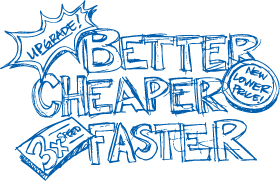Don’t Settle for Being an “-Er Brand”
I originally wrote this piece for the Harvard Business Review. It was published on HRB.org on March 28, 2014.

As a member of a start-up advisory program, I regularly hear pitches from aspiring technology entrepreneurs. My job is to sort out the companies with potential from those that need to go back to the drawing board. One way I do this is to use what I call the “-er brand” filter.
Er brands rely on other products or brands to explain their own. Hyundai is an -er brand. Its brand appeal is based on the assertion, “We’re just as good as Lexus but cheap-er.” Burger King is an -er brand, copying McDonald ‘s smoothies and wraps with claims to be light-er and healthi-er. When Microsoft introduced Bing, its assertion of offering a fast-er search engine than Google sealed Bing’s fate as an Internet service step-child.
Red flags go up whenever I hear a pitch that explains how a new offering is just like another but is small-er, bigg-er, thinn-er, light-er, fast-er, sexi-er, whatev-er. Hearing “we’re just like X brand but we’re…” sets off warning signals about breakthrough ability and long-term viability.
An -er position is a dangerous one to adopt. It relegates your brand to subordinate status compared to the brand used as your reference point – and it tells customers that your brand possesses only comparative value, rather than having its own inherent value. It also puts your brand under constant pressure to introduce new products on Brand X’s time line, because now your brand value is tied to Brand X’s product. You have little basis for achieving meaningful and sustained differentiation.
Great brands never settle for being an -er brand. The brands that capture the imagination of customers and investors alike are those that have no reference point other than themselves. Ben Horowitz of Andreessen Horowitz says his venture company invests in companies that present a breakthrough idea. “By definition they are not obvious. In fact, they seem insane. If they didn’t seem insane at the time, they wouldn’t be breakthroughs.”
That sets the bar quite high, and I understand not every product can be truly new to the world. But even if an offering is somewhat derivative, the brand can – and must — be clearly different. You shouldn’t have to use an existing brand to explain yours. A well-conceived brand platform and positioning can relegate competitors to irrelevance.
There are several ways to position a brand as breakthrough. Instead of – or in addition to — differentiating on the what of your brand, use the why, who, and how.
1. Why — purpose and values. A distinctive mission and values can be a powerful – and inimitable — way to connect with people. Dove showed how to break through in a commoditized category like bath soap with a compelling purpose, to celebrate every woman’s unique and real beauty. In the tech space, Etsy became so popular so quickly not only because of its unique product selection but also because of its commitment to the humanity and authenticity of craft.
2. Who — target customers. Some brands distinguish themselves based on who they’re for – and in some cases, who they’re not for. In the height of the flash sale website craze, Zulily was started as a site for discriminating moms. By positioning the brand between value-oriented mass brands and exclusive boutiques, the company attracted the attention of a certain type of shopper — and its success (consistent double-digit growth and a $2.6 billion IPO valuation in 2013) can be attributed to its continued focus on that target.
3. How – personality. When a unique brand personality manifests itself in a unique customer experience, it enables a brand to rise above competitive comparison. Southwest Airlines exists in a class of its own in large part due to its fun personality. Harley-Davidson, Trader Joe’s, and The Honest Co. are other companies that have leveraged their personalities to become extraordinary brands. Using brand personality in this way is not simply about developing creative communications; it’s about infusing every aspect of your operations with your unique character.
Every company chooses whether it wants to be a great brand or an -er brand. Great brands don’t settle for riding someone else’s wave. They chart their own course and invite the world to navigate around them.
related posts: